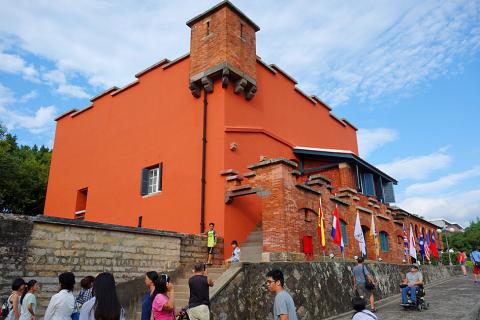The “Old Dutch Fort” in Fort San Domingo yesterday officially reopened after being closed for almost two years for restoration.
The landmark in New Taipei City’s Tamsui District (淡水), also known as Fort Antonio, was closed for renovation in January last year as widespread repairs were needed to fix leaking roofs and decaying exterior walls.
Repair work was finished in the middle of last month, followed by a one-month inspection by Tamsui Historical Museum officials.

Photo: Yeh Kuan-yu, Taipei Times
The museum, which is in charge of the national historic site, held a ceremony yesterday to celebrate the reopening of the fort — on the 370th anniversary of its establishment — as well as National Heritage Day and the museum’s own 11th anniversary.
Workshop in Heaven Theater (黑門山上的劇團) performed a play on the stories related to Fort San Domingo as part of the celebration.
The fort has been renovated three times, including the latest effort, museum officials said.
Water had infiltrated the fort’s structure because the roof could not drain properly, museum officials said, adding that the walls, which are about 1.7m thick, trap humidity inside the building, leading to cracks and decay, while the wooden floors had become moldy.
The restoration team also worked to ensure that the paint on the exterior walls resembled the one used by the Dutch builders, which turned out to be a challenge.
Museum officials said they sent paint samples taken from the walls before the 1985 restoration effort, after that restoration and after the 2004 restoration to be analyzed at a laboratory in Germany.
Based on its analysis of those samples, the laboratory suggested four colors for members the restoration supervisory committee to choose from for the exterior paint.
Fort San Domingo was established in 1629 by Spanish forces occupying northern Taiwan.
The original structure was destroyed during a nighttime attack in 1636 launched by Chinese merchants from China’s Fujian Province, who were upset by the taxes that the Spanish governor had imposed on their businesses.
The Spanish rebuilt the fort, which suffered major damage during a war with Dutch forces.
The Dutch rebuilt the fort after they ousted the Spanish from northern Taiwan, completing reconstruction in 1646, when the installation was renamed Fort Antonio.
As the locals called the Dutch “the red-haired people,” the fort became known as the “fort of the red-haired people” (紅毛城).

Taiwan is to commence mass production of the Tien Kung (天弓, “Sky Bow”) III, IV and V missiles by the second quarter of this year if the legislature approves the government’s NT$1.25 trillion (US$39.78 billion) special defense budget, an official said yesterday. Commenting on condition of anonymity, a defense official with knowledge of the matter said that the advanced systems are expected to provide crucial capabilities against ballistic and cruise missiles for the proposed “T-Dome,” an advanced, multi-layered air defense network. The Tien Kung III is an air defense missile with a maximum interception altitude of 35km. The Tien Kung IV and V

The disruption of 941 flights in and out of Taiwan due to China’s large-scale military exercises was no accident, but rather the result of a “quasi-blockade” used to simulate creating the air and sea routes needed for an amphibious landing, a military expert said. The disruptions occurred on Tuesday and lasted about 10 hours as China conducted live-fire drills in the Taiwan Strait. The Civil Aviation Administration (CAA) said the exercises affected 857 international flights and 84 domestic flights, affecting more than 100,000 travelers. Su Tzu-yun (蘇紫雲), a research fellow at the government-sponsored Institute for National Defense and Security Research, said the air

A strong continental cold air mass is to bring pollutants to Taiwan from tomorrow, the Ministry of Environment said today, as it issued an “orange” air quality alert for most of the country. All of Taiwan except for Hualien and Taitung counties is to be under an “orange” air quality alert tomorrow, indicating air quality that is unhealthy for sensitive groups. In China, areas from Shandong to Shanghai have been enveloped in haze since Saturday, the ministry said in a news release. Yesterday, hourly concentrations of PM2.5 in these areas ranged from 65 to 160 micrograms per cubic meter (mg/m³), and pollutants were

Taiwan’s armed forces have established response protocols for a wide range of sudden contingencies, including the “Wan Chun Plan” to protect the head of state, the Ministry of Defense (MND) said today. After US President Donald Trump on Saturday launched a series of airstrikes in Venezuela and kidnapped Venezuelan President Nicolas Maduro, concerns have been raised as to whether China would launch a similar “decapitation strike” on Taiwan. The armed forces regularly coordinate with relevant agencies and practice drills to ensure preparedness for a wide range of scenarios, Vice Minister of National Defense Hsu Szu-chien (徐斯儉) told reporters before a